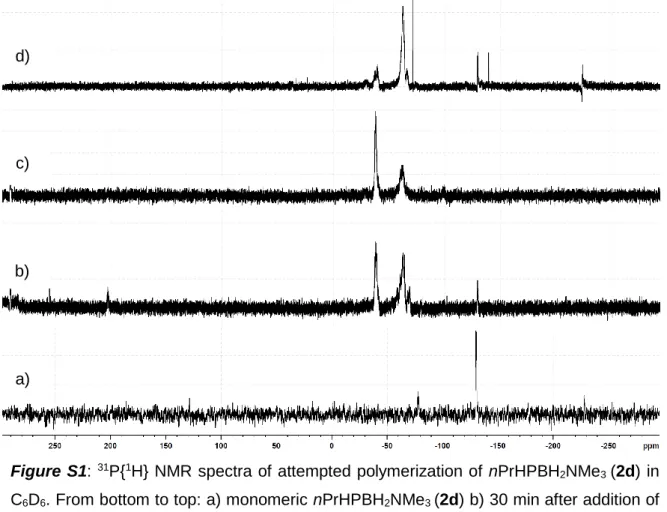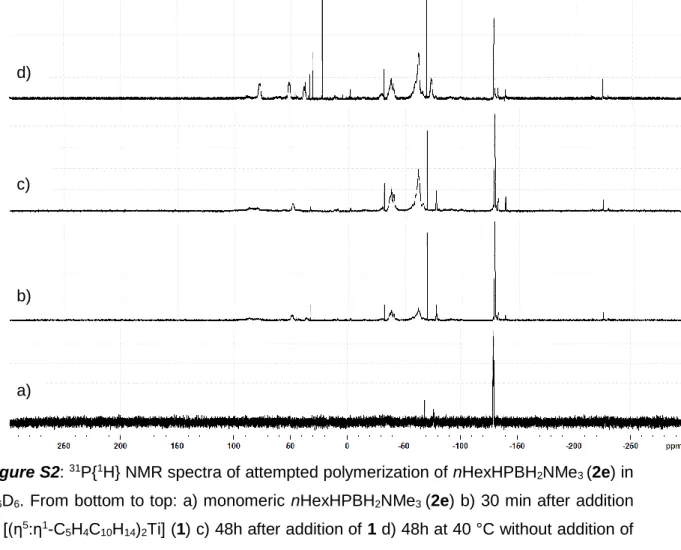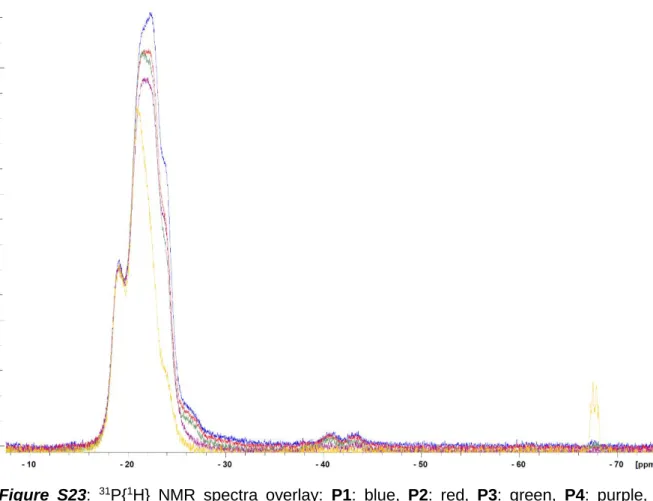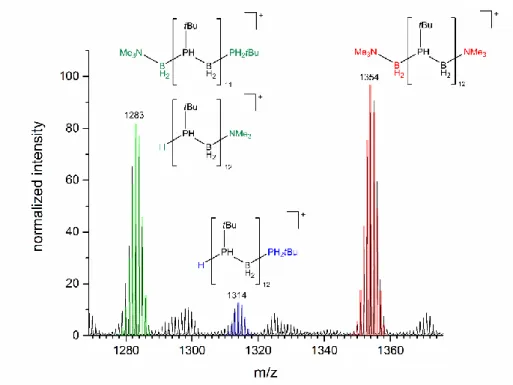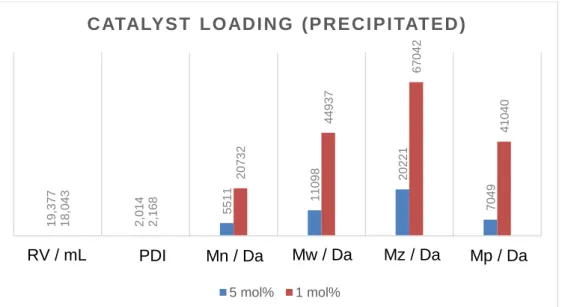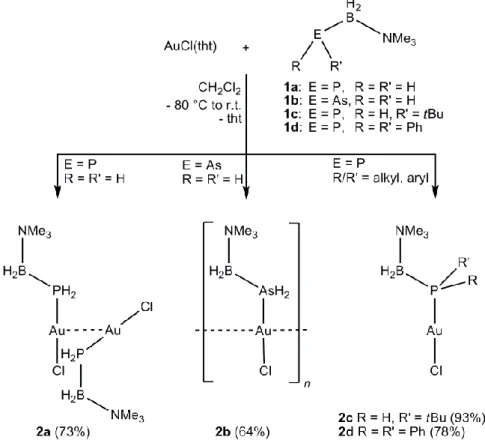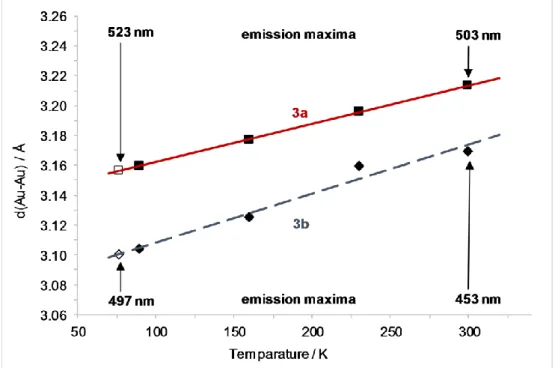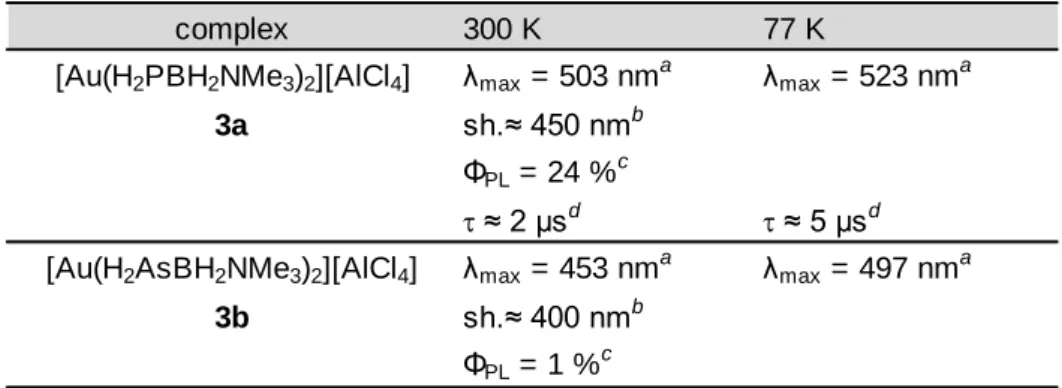Reactivity of Lewis Base Stabilized Pnictogenylboranes Towards
Transition Metal Complexes
DISSERTATION ZUR ERLANGUNG DES
DOKTORGRADES DER NATURWISSENSCHAFTEN (DR. RER. NAT.)
DER FAKULTÄT FÜR CHEMIE UND PHARMAZIE DER UNIVERSITÄT REGENSBURG
vorgelegt von Jens Braese aus Kulmbach
im Jahr 2018
Diese Arbeit wurde angeleitet von Prof. Dr. Manfred Scheer.
Promotionsgesuch eingereicht am: 30.11.2018 Tag der mündlichen Prüfung: 11.01.2019
Vorsitzender: Prof. Dr. Arnd Vogler Prüfungsausschuss: Prof. Dr. Manfred Scheer
Prof. Dr. Henri Brunner
Prof. Dr. Frank-Michael Matysik
Ich erkläre hiermit an Eides statt, dass ich die vorliegende Arbeit ohne unzulässige Hilfe Dritter und ohne Benutzung anderer als der angegebenen Hilfsmittel angefertigt habe; die aus anderen Quellen direkt oder indirekt übernommenen Daten und Konzepte sind unter Angabe des Literaturzitats gekennzeichnet.
___________________________
Jens Braese
Prof. Dr. Manfred Scheer.
Parts of this work have already been published:
J. Braese, A. Schinabeck, M. Bodensteiner, H. Yersin, A. Y. Timoshkin, M. Scheer, Chem. Eur. J. 2018, 24, 10073–10077.
"I’m just a simple man
trying to make my way in the universe."
Jango Fett
To my family, friends, supporters
and loved ones
Some of the presented results have already been published during the preparation of this work (vide supra). The relevant content is reprinted with permission of the respective scientific publisher. The corresponding citation and the respective license numbers are given at the beginning of the particular chapters.
Each chapter includes a list of authors. At the beginning of each chapter the individual contribution of each author will be described. Additionally, if some of the presented results have already been partly discussed in other theses, it is stated at the beginning of the respective chapters.
To ensure a uniform design of this work, all chapters are subdivided into ‘Introduction’,
‘Results and Discussion’, ‘Conclusion’, ‘References’, and ‘Supporting Information’.
Furthermore, all chapters have the same text settings and the compound numeration begins anew. Due to different requirements of the journals and different article types, the presentation of figures for single crystal X-ray structures or the ‘Supporting Information’
may differ. In addition, a general introduction is given at the beginning and a comprehensive conclusion of all chapters is presented at the end of this thesis.
Table of Contents
1. Introduction ... 1
1.1 Bonding Situation and Structure Types of Group 13/15 Compounds ... 1
1.2 Academic Interest and Application ... 2
1.3 Inorganic Oligomeric and Polymeric Compounds from Dehydrocoupling reactions ... 3
1.4 Lewis Base Stabilized Pnictogenylboranes ... 6
1.5 References... 8
2 Research Objectives ... 13
3 The Polymerization of Phosphinoborane by Titanium Complexes ... 17
3.1 Introduction ... 17
3.2 Results and Discussion ... 18
3.3 Conclusion ... 24
3.4 References... 24
3.5 Supporting Information ... 27
Synthethic Procedures ... 27
Polymerization Experiments ... 28
NMR spectroscopy ... 33
ESI-MS ... 44
GPC and DLS... 53
Computational Studies ... 56
References ... 57
4 Gold(I) Complexes Containing Phosphanyl- and Arsanylborane Ligands ... 61
4.1 Introduction ... 61
4.2 Results and Discussion ... 62
II | T a b l e o f C o n t e n t s
4.3 Conclusion ... 68
4.4 References ... 69
4.5 Supporting Information ... 72
General information ... 72
Syntheses of described compounds ... 72
Details of Crystal Structure Solution and Refinement ... 77
Crystal Structures ... 79
Crystallographic Information ... 87
NMR Spectroscopy ... 98
Computational Details ... 112
Photoluminescence ... 139
References ... 139
5 Coordination of Pnictogenylboranes Towards Monovalent Copper Compounds ... 143
5.1 Introduction ... 143
5.2 Results and Discussion... 144
5.3 Conclusion ... 151
5.4 References ... 152
5.5 Supporting Information ... 154
General information ... 154
Syntheses of described compounds ... 154
References ... 167
6 Thesis Treasury ... 169
6.1 Reactivity of Phosphanylboranes towards Rh(I) complexes ... 169
Syntheses of described compounds ... 173
References ... 175
7 Conclusion ... 177
7.1 Polymerization of Pnictogenylboranes ... 177
7.2 Coordination towards Au(I) and Cu(I) compounds ... 182
7.3 References... 185
8 Appendices ... 186
8.1 List of Abbreviations ... 186
8.2 Acknowledgments ... 189
1. Introduction
1.1 Bonding Situation and Structure Types of Group 13/15 Compounds
Compounds consisting of elements from both group 13 and group 15 with a direct bond between both elements are considered as inorganic analogues to hydrocarbon compounds: In a unit of two carbon atoms, substitution of one carbon atom by a group 13 element, e.g. B, and the other carbon atom by a group 15 element, e.g. N, leads to isoelectronic units.[1] Boron, bearing one valence electron less than carbon, and nitrogen, bearing one more valence electron than carbon, can conjointly build isoelectronic molecules, saturated as well as unsaturated ones (Figure 1).
Figure 1. Isoelectronic analogy between hydrocarbons and group 13/15 compounds.
This analogy can also be observed in cyclic molecules like borazine (B3N3H6), also called “inorganic benzene”, and even in solid state materials, for example boron nitride (BN)n. While borazine shows some of the typical characteristics of its aromatic analogue benzene (C6H6), being a colourless liquid with aromatic odor,[2] the aromaticity is significantly lower due to the polarity of the bonds between the group 13 and group 15 atoms. This is caused by the difference in the electronegativity between the boron and the nitrogen atom (EN = 1.0). Comparing ammonia borane (H3N·BH3) to ethane (C2H6), the bonding situation is pictorially better described as a dative bond from the nitrogen atom to the boron atom. In this work, the dative bond model is used if it’s adding clarity, otherwise plain bonds are depictured. A zwitterionic Lewis structure H3N+--BH3 could also
2 | I n t r o d u c t i o n
be used to describe the bonding situation, although computational studies show that just 0.2 e- are transferred from nitrogen to boron, locating the bonding electron pair closer to nitrogen.[3] In comparison to a C-C single bond, this leads to a weaker bond, which is subsequently influencing the reactivity. The bond length is elongated compared to hydrocarbons, the distance between the two atoms is approximately 0.04 Å longer for all examples in Figure 1. The solid state material boron nitride (BN)n occurs in the three different modifications, hexagonal (α), cubic (β) and wurtzite type (γ). A graphite like layer structure can be observed in the hexagonal phase, while the cubic β-BN shows a diamond like lattice. The γ-phase shows the same structure as lonsdaleite, the high pressure hexagonal diamond.
1.2 Academic Interest and Application
The first report of a group 13/15 compound dates back to the year 1809, a decade after the French revolution, when the ammonia-borane adduct H3N·BF3 was described by the famous French scientist Gay-Lussac.[4] The first description of the heavier congener H3P·BCl3 took place much later in 1890, also containing a fully halogenated borane.[5] The presence of trihydridoboron in Me3N·BH3 was reported in 1937 by Burg and Schlesinger.[6] Based on their work, the isolation of the fully hydrogen substituted ammonia borane H3N·BH3 was achieved in 1955,[7] followed by the characterization of H3P·BH3 a decade later.[8] These only hydrogen substituted compounds H3E·BH3 (E = N, P, As, Sb) are of special academic interest because they represent the parent compounds of substituted pnictogen hydride boranes.[9] For application, they are promising candidates for hydrogen storage materials, especially H3N·BH3 due to its high hydrogen content up to 19.6 wt-%.[10] Up to three equivalents of dihydrogen can be released by thermolysis. In this case, the thermodynamically very stable boron nitride (BN)n is formed. Substitution on the main group elements can still be beneficial to improve the properties by electronical and sterical effects and influence the workability of resulting materials by altering e.g. the solubility or thermal stability.[11] Catalysis by transition metal complexes can be applied to lower the activation barrier of the hydrogen release and control the degree of dehydrogenation. Recent studies showed also promising results in regenerating partially dehydrogenated compounds.[12]
Dehydrogenation can lead to formation of new bonds via dehydrocoupling, resulting in inorganic oligomeric and polymeric compounds, which will be discussed in the following chapter. Besides being promising candidates for hydrogen storage materials, poly(aminoborane)s are examined as potential preceramic materials. Processed into the desired shapes, subsequent pyrolyzation can then produce α-boron nitride forms. Boron
phosphide attracts significant interest due to its semiconducting properties,[13] for which poly(phosphinoborane)s are discussed as precursors. Films of polymeric [(p- CF3C6H4)HP-BH2]n were successfully tested for application in electron beam lithography.[14] At present, group 13/15 compounds are already used as abrasives,[15]
flame retardants,[16] high temperature ceramics[1] or as semiconducting materials in opto- and microelectronic devices.[17]
1.3 Inorganic Oligomeric and Polymeric Compounds from Dehydrocoupling reactions
Dehydrocoupling describes the process of the formation of a new chemical bond with simultaneous release of dihydrogen. This can lead to the aggregation of small molecules to bigger oligomeric and polymeric units. Subject for such reactions can be the release of dihydrogen or the generation of new materials or both. Especially dehydrocoupling reactions of amine- and phosphine-borane adducts have been intensively studied. The reaction can be induced either by thermolysis[18] or with metal catalysts.[19] The first metal catalyzed dehydrocoupling reaction of amine-boranes was mentioned in a patent in 1989.[20] A decade later, Manners et al. described the first coupling of phosphine-borane Ph2HP·BH3 to dimeric species Ph2HP-BH2-Ph2P-BH3 (I, Figure 2), using the transition metal precatalysts [Rh(COD)2][OTf] or [Rh(-Cl)(COD)]2 (COD = cycloocta-1,5-diene).[21]
Using the mono-substituted phosphine-borane PhH2P·BH3 under similar conditions leads to the formation of polymeric product [PhHP-BH2]n (II). Later studies comprised the first in detail investigation on catalytic dehydrocoupling of amine-boranes, also using Rh(I) complexes or [RhCl3·3H2O].[19c,22] Similar to dehydrocoupling reactions of phosphine- borane, the product is strongly influenced by the substitution on the pnictogen atom.
Secondary amine-boranes RR’HN·BH3 (R/R’ = Me, Bn, 1,4-C4H8 = pyrrolidine) form cyclic dimers (III) by dehydrocoupling, while bulky substituents prevent dimerization and stabilize monomeric species like iPr2N=BH2 (IV). Mono-substituted compounds RH2N·BH3 (R = H, Me, Ph) afford cyclic trimers (V) upon dehydrocoupling. Subsequent heating leads to further hydrogen loss and formation of N-substituted borazines (VI).
Since then, a variety of transition metal complexes and nanoparticles (Ti, Cr,[23] Fe,[24]
Ni,[25] CoCu,[26] Zr, Ru,[19f,27] Rh, Ir,[28] Pt[29]) and also main group compounds[30] have been tested for catalytic activity in dehydrocoupling experiments of amine- and phosphine- borane adducts.
4 | I n t r o d u c t i o n
Figure 2. Dehydrocoupling of secondary and primary phosphine- and amine-boranes.
In addition to the Rh(I) species, exemplified results will be discussed in the following.
An example for an active main group catalyst is the Lewis acid B(C6F5)3, which was reacted with the in-situ generated parent compound H3P·BH3.[11b] Under evolution of hydrogen, the formation of poly(phosphinoborane) [H2P–BH2]n is assumed, although the product was not indubitable characterized due to its sensitivity. Substrate Ph2HP·BH3
gives rise to the polymeric product [PhHP-BH2]n (II), the same product as from Rh(I) catalysis. Recently, it was shown that also catalysts based on earth abundant Fe can be used for the synthesis of poly(phosphinoborane)s, while allowing the control of the molecular weight of the polymers.[31] Worth mentioning is the use of Brookhart’s [IrH2(POCOP)] catalyst (POCOP = [μ3-1,3-(OPtBu2)2C6H3]), which allows efficient dehydrocoupling of the parent compound H3N·BH3, forming either cyclic pentamers [H2N-BH2]5[28a] or linear polymers [H2N-BH2]n from higher monomer concentrations.[32]
Similar to these findings, mono-substituted amine-boranes give rise to oligomeric compounds from reactions of lower monomer concentrations while higher concentrations lead to polymeric materials [RHN-BH2]n (R = H, Me, nBu) (VII).[32,33]
Another interesting class of catalysts are based on early transition metals titanium and its heavier homologue zirconium. [Cp2Ti], generated in situ from [Cp2TiCl2] with 2 equivalents of nBuLi, functions as an efficient homogenous catalyst for the dehydrogenation of secondary amine-borane adducts. R2HN·BH3 (R = Me, iPr) show total conversion at room temperature within minutes. The formed products are the same as with the use of Rh(I) catalysts.[34] A series of active TiII and ZrII precatalysts for
dehydrocoupling reactions has been investigated, of which the Ti-based precatalysts were found to be far more active than their Zr-based congeners.[35,36,37] Mechanistic investigations propose a N-H bond activation and the formation of a MIV intermediate (Figure 3), which was isolated for ZrIV, but only proposed for TiIV. For subsequent steps, an off-metal process was suggested by Luo and Ohn,[37] which involves hydride transfer from boron to the metal, resulting in monomeric Me2N=BH2 and [Cp2TiH2]. The former was supposed to dimerize towards a cyclic dimer (III), while the latter releases H2 to re- form [Cp2Ti]. Manners and Lloyd-Jones on the other hand proposed a two-stage catalytic cycle, in which a linear diborazane intermediate Me2NH-BH2-NMe2-BH3 (similar to I) is formed (and also detected by NMR spectroscopy) after initial N-H activation. A subsequent on-metal ring closing dehydrogenation step gives rise to the cyclic dimer (III). Once again, a interplay of TiII and TiIV intermediates is postulated.[38] However, this system was completely inactive towards the parent compound H3N·BH3 and it showed only negligible reaction rates towards primary amine-boranes. Interestingly, Wolstenholme and McGrady isolated a paramagnetic TiIII species [Cp2Ti(NH2BH3)]
(Figure 3) from reaction of [Cp2TiCl2] with Li[NH2BH3], which suggests that the presence of MIII (M = Ti, Zr) species on catalytic dehydrogenation reactions should not be dismissed.[34b] From stochiometric reactions of in-situ generated [Cp2Ti] with both secondary amine- and phosphine-boranes, further TiIII complexes [Cp2Ti(NMe2BH3)] and [Cp2Ti(PPh2BH3)] (Figure 3) could be isolated.[35] Both show activities as precatalysts for dehydrocoupling of Me2HN·BH3, via a Me2NH-BH2-NMe2-BH3 intermediate, towards formation of a cyclic dimer (III). This strengthens the assumption of a key catalytic role of a paramagnetic TiIII species in dehydrocoupling reactions of amine-boranes.
Figure 3. Proposed (TiIV) and isolated (ZrIV and TiIII) amido- and phosphidoborane species.
For phosphine-borane substrates, recent studies of the coordination chemistry at d- block metal centers gave inside into the formation of new P-B bonds via dehydrogenation in oligomeric and polymeric materials.[39] The P-H moiety serves a double purpose: The activation of the P-H bond leads to the formation of metal- phosphidoborane intermediates and the P-B bond formation is promoted via dehydrogenative coupling of a protic P-H and a hydridic B-H moiety with simultaneous
6 | I n t r o d u c t i o n
release of dihydrogen.[31a,39] Since the P-H bonds are essentially non-polar (EN = 0.01), this limits the reactions to substrates containing electron withdrawing effects from aryl groups on the phosphorus atom. Therefore, there are only very limited examples of poly(alkylphosphinoborane)s prepared via dehydrocoupling reactions, featuring electron donating alkyl substituents. iBuPH2·BH3[40] and FcCH2PH2∙BH3[41] in reaction with Rh(I) catalysts leads to the formation of polymeric materials, displaying rather unwanted properties like low molecular masses or highpolydispersity indices when compared to other poly(phosphinoborane)s. Though it should be mentioned that there is a completely different pathway towards poly(alkylphosphinoborane)s which doesn’t involve dehydrocoupling processes. Instead it makes use of Lewis base stabilized phosphanylboranes RR’PBH2∙LB (R/R’ = H, alkyl, aryl; LB = NMe3, SMe2), which will be discussed in the following chapter.
1.4 Lewis Base Stabilized Pnictogenylboranes
Pnictogenylboranes [R2EBR’2] (E = pnictogen atom; R/R’ = H, alkyl, aryl) can be viewed as the inorganic equivalents of ethene, but as monomeric species they are commonly not stable under ambient conditions. This can be explained due to an empty p-orbital at the boron atom together with an available lone pair on the pnictogen atom (Figure 3). The free electron pair can interact with the vacant orbital of a second molecule, leading to a head-to-tail oligomerization/polymerization. This behavior, used in a controlled manner, can be utilized for the synthesis of new polymeric materials.
Figure 3. Head-to-tail oligomerization of pnictogenylboranes.
The monomeric species can be stabilized trough sterical hinderance, among other things, as observed e.g. in tBu2AsBMes2.[42] Less sterical hindered compounds, like the parent compound NH2BH2, which could be isolated only at cryogenic conditions,[43] can be stabilized in the coordination sphere of transition metal fragments like [RuH2(PCy3)2(η2-η2-H2NBH2)].[44] Stabilization can also be realized through Lewis acids, which can accept the electron pair of the pnictogen atom, and Lewis bases, which can donate into the vacant orbital at the boron atom. Like this, stabilized parent compounds
[BH3·H2NBH2·DMAP][45] and [W(CO)5·H2EBH2·NMe3][46] (E = P, As) could be realized.
Further investigations by our group gave rise to only Lewis base stabilized compounds H2EBH2·NMe3 (E = P, As) that can be achieved through abstraction of the [W(CO)5] fragment by P(OMe)3.[47] Such compounds can also be obtained by direct synthesis via salt metathesis reactions, giving access also to the heavier homologues H2EBH2·LB (E = P, As, Sb; LB = NMe3 or NHCMe for Sb).[48] The azaborane H2NBH2·LB however is not is accessible by these methods. Although it could be obtained by Manners et al. through the cleavage of polymers [H2N–BH2]n or [MeHN–BH2]n by addition of the strong Lewis base NHCDipp.[49] Moreover, mixed pnictogenylboranes could recently be stabilized by our group. Although also requiring both Lewis acid and Lewis base stabilization, W(CO)5·PH2BH2ER2BH2·LB (E = P, As, Sb; R = H (except for Sb), SiMe3; LB = NMe3 or NHCMe for Sb) could be obtained, which might be interesting building blocks for copolymers.[50]
Thermal treatment of phosphanylboranes RR’PBH2∙NMe3 (R/R’ = H, alkyl, aryl; LB = NMe3) can lead to the elimination of the stabilizing Lewis base NMe3 and a head-to- tail polymerization of the intermediate [RR’PBH2], giving rise to oligomeric and polymeric compounds. The resulting material is strongly influenced by the substituents on the phosphorus atom. Heating of parent compound H2PBH2∙NMe3
results in a insoluble precipitate, presumably [H2PBH2]n and further small or branched oligomers.[24] Electron withdrawing aryl-substituents increase the solubility, the thermally induced polymerization of Ph2PBH2∙NMe3 resulted in oligomeric material [Ph2PBH2]n, showing only a limited number of repeating units (n < 6). Gentle thermolysis of alkylated MeHPBH2∙NMe3 afford soluble poly(alkylphosphinoborane)s with at least 40 repeating units.[51] The best results were obtained from mild thermolysis of tBuHPBH2∙NMe3 at 40
°C, resulting in well soluble, high molecular mass material [tBuHPBH2]n with more than 2000 repeating units.[24] Experiments in our group have shown that thermal treatment of the heavier homologues RR’EBH2∙NMe3 (E = As, Sb) does not result in the elimination of NMe3 and the formation of new E-B bonds, but rather in the breaking of the already existing E-B bonds or a complete decomposition of the starting material.
To further promote poly- and oligomerization, the parent compound H2PBH2∙NMe3
has been reacted with transition metal complex [Cp2Ti(btmsa)] (btmsa = bis(trimethylsilyl)acetylene) as a source of [Cp2Ti], compare chapter 1.3. Initially, the adduct complex [Cp2Ti(btmsa)(H2PBH2∙NMe3)] is formed at -80 °C.[52] Upon warming to room temperature, stepwise aggregation on titanium complex centers to form phosphinoborane oligomers (n = 3, 4, 6) can be observed (Figure 4). This process includes elimination of NMe3 as well as dehydrocoupling steps to form new P-B (and also
8 | I n t r o d u c t i o n
P-P) bonds, while the catenae molecule is stabilized in the coordination sphere of [Cp2Ti]
via Ti-P, Ti-B and Ti-H-B interactions.
Figure 4. Phosphinoborane oligomers stabilized in the coordination sphere of [Cp2Ti].
Based on these findings, the reaction of Lewis base stabilized pnictogenylboranes towards transition metal complexes should be further investigated in this thesis.
1.5 References
[1] A. F. Hollemann, E.Wiberg, Lehrbuch der Anorganischen Chemie, Vol. 102, Walter de Gruyter Verlag, Berlin-New York, 2007, 1111-1126.
[2] A. Stock, E. Pohland, Ber. Dtsch. Chem. Ges. 1926, 59, 2215–2223.
[3] H. Umeyama, K. Morokuma, J. Am. Chem. Soc. 1976, 98, 7208–7220.
[4] J. L. Gay-Lussac, J. L. Thénard, Mem. de. Phys. et de. Chim. de la Soc. d’Arcueil 1809, 2, 210 as cited in V. Jonas, G. Frenking, J. Chem. Soc., Chem. Commun.
1994, 1489–1490.
[5] A. Besson, Comptes Rendus 1890, 516.
[6] A. B. Burg, H. I. Schlesinger, J. Am. Chem. Soc. 1937, 59, 780–787.
[7] S. G. Shore, R. W. Parry, J. Am. Chem. Soc. 1955, 77, 6084-6085.
[8] R. W. Rudolph, R. W. Parry, C. F. Farran, Inorg. Chem. 1966, 5, 723-726.
[9] R. T. Paine, H. Nöth, Chem. Rev. 1995, 95, 343–379.
[10] C. W. Hamilton, R. T. Baker, A. Staubitz, I. Manners, Chem. Soc. Rev. 2009, 38, 279–293.
[11] a) X. Feng, M. M. Olmstead, P. P. Power, Inorg. Chem. 1986, 25, 4615–4616; b) J.-M. Denis, H. Forintos, H. Szelke, L. Toupet, T.-N. Pham, P.-J. Madec, A.-C.
Gaumont, Chem. Commun. 2003, 54−55.
[12] a) L. Winner, W. C. Ewing, K. Geetharani, T. Dellermann, B. Jouppi, T. Kupfer, M.
Schäfer, H. Braunschweig, Angew. Chem. Int. Ed. 2018, 57, 12275–12279;
Angew. Chem. 2018, 130, 12455-12459; b) C. Reller, F. O. R. L. Mertens, Angew.
Chem. Int. Ed. 2012, 51, 11731–11735; Angew. Chem. 2012, 124, 11901–11905;
c) B. L. Davis, D. A. Dixon, E. B. Garner, J. C. Gordon, M. H. Matus, B. Scott, F. H.
Stephens, Angew. Chem. Int. Ed. 2009, 48, 6812–6816; Angew. Chem. 2009, 121, 6944–6948; d) A. D. Sutton, A. K. Burrell, D. A. Dixon, E. B. Garner III, J. C.
Gordon, T. Nakagawa, K. C. Ott, J. P. Robinson, M. Vasiliu, Science 2011, 331, 1426–1429; e) A. P. M. Robertson, E. M. Leitao, I. Manners, J. Am. Chem. Soc.
2011, 133, 19322–19325; e) E. M. Leitao, N. E. Stubbs, A. P. M. Robertson, H.
Helten, R. J. Cox, G. C. Lloyd-Jones, I. Manners, J. Am. Chem. Soc. 2012, 134, 16805–16816; f) P. Paetzold, Adv. Inorg. Chem. 1987, 31, 123–170.
[13] Y. Kumashiro, J. Mater. Res. 1990, 5, 2933–2947.
[14] T. J. Clark, J. M. Rodezno, S. B. Clendenning, S. Aouba, P. M. Brodersen, A. J.
Lough, H. E. Ruda, I. Manners, Chem. Eur. J. 2005, 11, 4526–4534.
[15] R. H. Todd, D. K. Allen, L. Alting, Manufacturing Processes Reference Guide, Industrial Press Inc, New York, 1994, 43–48.
[16] a) G. W Parshall, The Chemistry of Boron and its Compounds; Muetterties, E. L., Ed.; Wiley: New York, 1967, 617; b) Haiduc, I. The Chemistry of Inorganic Ring Systems; Wiley: New York, 1970, 349.
[17] a) R. L. Wells, W. L. Gladfelter, J. Cluster Sci. 1997, 8, 217–237; b) F. Maury, Adv.
Mater. 1991, 3, 542–548;
[18] a) S. Frueh, R. Kellett, C. Mallery, T. Molter, W. S. Willis, C. King’ondu, S. L. Suib, Inorg. Chem. 2011, 50, 783–792; b) M. G. Hu, R. A. Geanangel, W. W. Wendlandt, Thermochim. Acta 1978, 23, 249–255; c) F. Baitalow, J. Baumann, G. Wolf, K.
Jaenicke-Rössler, G. Leitner, Thermochim. Acta 2002, 391, 159–168; d) V. Sit, R.
A. Geanangel, W. W. Wendlandt, Thermochim. Acta 1987, 113, 379–382; e) G.
Wolf, J. Baumann, F. Baitalow, F. P. Hoffmann, Thermochim. Acta 2000, 343, 19–
25; f) J. Baumann, F. Baitalow, G. Wolf, Thermochim. Acta 2005, 430, 9–14.
[19] a) S. S. Mal, F. H. Stephens, R. T. Baker, Chem. Commun. 2011, 47, 2922–2924;
b) T. Umegaki, J.-M. Yan, X.-B. Xhang, H. Shioyama, N. Kuriyama, Q. Xu, Int. J.
Hydrogen Energy 2009, 34, 2303–2311; c) C. A. Jaska, K. Temple, A. J. Lough, I.
Manners, J. Am. Chem. Soc. 2003, 125, 9424–9434; d) C. A. Jaska, I. Manners, J.
Am. Chem. Soc. 2004, 126, 1334–1335; e) Y. Chen, J. L. Fulton, J. C. Linehan, T.
Autrey, J. Am. Chem. Soc. 2005, 127, 3254–3255; f) N. Blaquiere, S. Diallo- Garcia, S. I. Gorelsky, D. A. Black, K. Fagnou, J. Am. Chem. Soc. 2008, 130, 14034–14035; g) W. R. H. Wright, E. Berkeley, L. G. Sneddon, R. T. Baker, Chem.
Commun., Chem. Commun. 2011, 47, 3177-3179.
[20] Y. D. Blum, R. M. Laine, U.S. Pat. 4801439, 1989.
[21] H. Dorn, R. A. Singh, J. A. Massey, A. J. Lough, I. Manners, Angew. Chem. Int. Ed.
1999, 38, 3321–3323, Angew. Chem. 1999, 111, 3540–3543.
[22] C. A. Jaska, K. Temple, A. J. Lough, I. Manners, Chem. Commun. 2001, 962–963.
[23] Y. Kawano, M. Uruichi, M. Shimoi, S. Taki, T. Kawaguchi, T. Kakizawa, H. Ogino, J. Am. Chem. Soc. 2009, 131, 14946–14957.
[24] C. Marquardt, T. Jurca, K.-C. Schwan, A. Stauber, A. V. Virovets, G. R. Whittell, I.
Manners, M. Scheer, Angew. Chem. Int. Ed. 2015, 54, 13782-13786; Angew.
Chem. 2015, 127, 13986-13991.
[25] a) R. J. Keaton, J. M. Blacquiere, R. T. Baker, J. Am. Chem. Soc. 2007, 129, 1844–1845; b) X. Yang, M. B. Hall, J. Am. Chem. Soc. 2008, 130, 1798–1799; c) P. M. Zimmerman, A. Paul, C. B. Musgrave, Inorg. Chem. 2009, 48, 5418–5433; d) L. Yang, W. Luo, G.-Z. Cheng, Catal. Lett. 2013, 143, 873–880.
[26] C. Li, J. Zhou, W. Gao, J. Zhao, J. Liu, Y. Zhao, M. Wei, D. G. Evans, X. Duan, J.
Mater. Chem. A 2013, 1, 5370–5376.
[27] a) A. N. Marziale, A. Friedrich, I. Klopsch, M. Drees, V. R. Celinski, Schmedt auf der Günne, Jörn, S. Schneider, J. Am. Chem. Soc. 2013, 135, 13342–13355; b) D.
F. Schreiber, C. O’Connor, C. Grave, Y. Ortin, H. Müller-Bunz, A. D. Phillips, ACS Catal. 2012, 2, 2505–2511; c) H. Ma, C. Na, ACS Catal. 2015, 5, 1726–1735; d) A.
Friedrich, M. Drees, S. Schneider, Chem. Eur. J. 2009, 15, 10339–10342; e) M.
Käß, A. Friedrich, M. Drees, S. Schneider, Angew. Chem. 2009, 121, 922–924;
Angew. Chem. Int. Ed. 2009, 48, 905–907.
[28] a) M. C. Denney, V. Pons, T. J. Hebden, D. M. Heinekey, K. I. Goldberg, J. Am.
Chem. Soc. 2006, 128, 12048–12049; b) A. Paul, C. B. Musgrave, Angew. Chem.
2007, 119, 8301–8304; Angew. Chem. Int. Ed. 2007, 46, 8153–8156; c) T. J.
Hebden, K. I. Goldberg, D. M. Heinekey, X. Zhang, T. J. Emge, A. S. Goldman, K.
10 | I n t r o d u c t i o n
Krogh-Jespersen, Inorg. Chem. 2010, 49, 1733–1742; d) D. J. Nelson, B. J.
Truscott, J. D. Egbert, S. P. Nolan, Organometallics 2013, 32, 3769–3772.
[29] M. Roselló-Merino, J. López-Serrano, S. Conejero, J. Am. Chem. Soc. 2013, 135, 10910–10913.
[30] a) J. Spielmann, G. Jansen, H. Bandmann, S. Harder, Angew. Chem. 2008, 120, 6386–6391; Angew. Chem. Int. Ed. 2008, 47, 6290–6295; b) D. J. Liptrot, M. S.
Hill, M. F. Mahon, D. J. MacDougall, Chem. Eur. J. 2010, 16, 8508–8515; c) A. J.
M. Miller, J. E. Bercaw, Chem. Commun. 2010, 46, 1709–1711; d) G. R. Whittell, E. I. Balmond, A. P. M. Robertson, S. K. Patra, M. F. Haddow, I. Manners, Eur. J.
Inorg. Chem. 2010, 25, 3967–3975; e) M. M. Hansmann, R. L. Melen, D. S. Wright, Chem. Sci. 2011, 2, 1554–1559; f) H. Helten, A. P. M. Robertson, A. Staubitz, J. R.
Vance, M. F. Haddow, I. Manners, Chem. Eur. J. 2012, 18, 4665–4680.
[31] a) A. Schäfer, T. Jurca, J. Turner, J. R. Vance, K. Lee, V. A. Du, M. F. Haddow, G.
R. Whittell, I. Manners, Angew. Chem. Int. Ed. 2015, 54, 4836–4841; Angew.
Chem. 2015, 127, 4918–4923; b) J. R. Vance, A. Schäfer, A. P. M. Robertson, K.
Lee, J. Turner, G. R. Whittell, I. Manners, J. Am. Chem. Soc. 2014, 136, 3048–
3064.
[32] A. Staubitz, A. P. Soto, I. Manners, Angew. Chem. Int. Ed. 2008, 47, 6212–6215, Angew. Chem. 2008, 120, 6308–6311.
[33] B. L. Dietrich, K. I. Goldberg, D. M. Heinekey, T. Autrey, J.C. Linehan, Inorg.
Chem. 2008, 47, 8583–8585.
[34] a) T. J. Clark, C. A. Russell, I. Manners, J. Am. Chem. Soc. 2006, 128, 9582-9583;
b) M. E. Sloan, A. Staubitz, T. J. Clark, C. A. Russell, G. C. Lloyd-Jones, I.
Manners, J. Am. Chem. Soc. 2010, 132, 3831–3841.
[35] H. Helten, B. Dutta, J. R. Vance, M. E. Sloan, M. F. Haddow, S. Sproules, D.
Collison, G. R. Whittell, G. C. Lloyd-Jones, I. Manners, Angew. Chem. Int. Ed.
2013, 52, 437–440.
[36] a) D. Pun, E. Lobkovsky, P. J. Chirik, Chem. Commun. 2007, 3297–3299; b) T.
Beweries, S. Hansen, M. Kessler, M. Klahn, U. Rosenthal, Dalton Trans. 2011, 40, 7689–7692.
[37] Y. Luo, K. Ohno, Organometallics 2007, 26, 3597–3600.
[38] M. E. Sloan, A. Staubitz, T. J. Clark, C. A. Russell, G. C. Lloyd-Jones, I. Manners, J. Am. Chem. Soc. 2010, 132, 3831–3841.
[39] a) M. A. Huertos, A. S. Weller, Chem. Commun. 2012, 48, 7185–7187; b) M. A.
Huertos, A. S. Weller, Chem. Sci. 2013, 4, 1881–1888; c) T. N. Hooper, M. A.
Huertos, T. Jurca, S. D. Pike, A. S. Weller, I. Manners, Inorg. Chem. 2014, 53, 3716–3729; d) H. C. Johnson, T. N. Hooper, A. S. Weller, Top. Organomet. Chem.
2015, 49, 153–220.
[40] H. Dorn, J. M. Rodezno, B. Brunnhöfer, E. Rivard, J. A. Massey, I. Manners, Macromolecules 2003, 36, 291−297.
[41] S. Pandey, P. Lönnecke, E. Hey-Hawkins, Eur. J. Inorg.Chem. 2014, 2456–2465.
[42] a) M. A. Petrie, M. M. Olmstead, H. Hope, R. A. Bartlett, P. P. Power, J. Am.
Chem. Soc. 1993, 115, 3221-3226; b) M. A. Mardones, A. H. Rowley, L. Contreras, R. A. Jones, J. Organomet. Chem. 1993, 455, C1-C2; c) P. P. Power, Chem. Rev.
1999, 99, 3463-3503.
[43] C. Y. Tang, A. L. Thompson, S. Aldridge, Angew. Chem. Int. Ed. 2010, 49, 921–
925; Angew. Chem. 2010, 122, 933 –937.
[44] G. Alcaraz, L. Vendier, E. Clot, S. Sabo-Etienne, Angew. Chem. Int. Ed. 2010, 49, 918 –920; Angew. Chem. 2010, 122, 930–932.
[45] A. C. Malcolm, K. J. Sabourin, R. McDonald, M. J. Ferguson, E. Rivard, Inorg.
Chem. 2012, 51, 12905−12916.
[46] U. Vogel, P. Hoemensch, K.-C. Schwan, A. Y. Timoshkin, M. Scheer, Chem. Eur.
J. 2003, 9, 515-520.
[47] K. Schwan, A. Timoshkin, M. Zabel, M. Scheer, Chem. Eur. J. 2006, 12, 4900–
4908.
[48] C. Marquardt, O. Hegen, M. Hautmann, G. Balázs, M. Bodensteiner,A. V. Virovets, A. Y. Timoshkin, M. Scheer, Angew. Chem. Int. Ed. 2015, 54, 13122–13125;
Angew. Chem. 2015, 127, 13315–13318.
[49] N. E. Stubbs, T. Jurca, E. M. Leitao, C. H. Woodall, I. Manners, Chem. Commun.
2013, 49, 9098–9100.
[50] O. Hegen, C. Marquardt, A. Y. Timoshkin, M. Scheer, Angew. Chem. Int. Ed. 2017, 56, 12783-12787; Angew. Chem. 2017, 129, 12959-12963.
[51] A. Stauber, T. Jurca, C. Marquardt, M. Fleischmann, M. Seidl, G. R. Whittell, I.
Manners, M. Scheer, Eur. J. Inorg. Chem. 2016, 17, 2684-2687.
[52] C. Thoms, C. Marquardt, M. Bodensteiner, M. Scheer, Angew. Chem. Int. Ed.
2013, 52, 5150-5154; Angew. Chem. 2013, 125, 5254-5259.
2 Research Objectives
Since the parent compound H2PBH2∙NMe3 has been successfully reacted with the transition metal complex [Cp2Ti(btmsa)] to promote oligomerization, the reaction of Lewis base stabilized pnictogenylboranes towards transition metal complexes should be further investigated. Known precatalysts for dehydrocoupling reactions of group 13/15 compounds as well as new complexes should be tested for possible catalytic activities with Lewis base stabilized pnictogenylboranes. This includes testing of complexes known for activation of E-H bonds in small molecules as well as a series of monovalent salts MX (M = transition metal, X = Cl, Br, I), which showed in the past great potential of building multinuclear complexes in our group. As we know, the substituents on the pnictogen atom play a key role in the formation of new oligomeric and polymeric species.
Therefore, a series of substituted pnictogenylboranes RR’EBH2∙NMe3 (E = P, As, Sb; R
= H, alkyl, aryl) should be tested in these reactions. Especially alkyl-substituted phosphinoboranes are of interest for the synthesis of poly(alkylphosphinoborane)s, because these kinds of inorganic polymers are hard to access via dehydrocoupling reactions. Because reactions of the heavier homologues RR’EBH2∙NMe3 (E = As, Sb) are not suitable for thermolysis, lowering the activation barrier via the addition of a transition metal precatalyst might bring new perspectives to this field. The reactions are to be carried out in stoichiometric ratios with the goal of isolating transient species that also come into play in catalytic reactions or coordination complexes of non-catalytic reactions. Sub stoichiometric amounts of metal complexes in different amounts and varying ambient conditions should be used in case of catalytic activities to get further insight into the ongoing reaction pathway. Proper characterization of the obtained oligomeric or polymeric products is essential for these investigations. The release of a free oligomer or polymer would represent a new class of catalytic polymerization reaction of Lewis base stabilized pnictogenylboranes. Reaction with active precatalysts for oligomerization/polymerization reactions includes:
• Stoichiometric reactions with the goal of isolating coordination products (including transient species) and characterization of the obtained products.
• Substoichiometric reactions applying different reaction conditions to get further insight into the ongoing reaction pathway.
• Characterization of possible oligomeric and polymeric products.
• Evaluation of the substrate scope and synthesis of new starting materials.
14 | R e s e a r c h O b j e c t i v e s
Not all reactions of transition metal complexes with pnictogenylboranes lead to an oligomerization or polymerization of the group 13/15 compounds. Coordination towards transition metal centers is a first step in the coordination chemistry of pnictogenylboranes and can result in complexes with intriguing properties. Lewis base stabilized pnictogenylboranes R2EBH2·NMe3 (E = P, As; R = H, alkyl, aryl) are special phosphines and arsines: they are good -donors, they feature an electropositive BH2∙NMe3
substituent and the sterical and electronical environment can be easily controlled through the variation of the organic substituents. Moreover, the parent compounds H2EBH2·NMe3
(E = P, As) can be used as special primary phosphine or arsine ligands respectively, which are much less common than their fully organic substituted derivates. Coordination to a metal center can result in complexes that are unprecedented with such small, primary ligands, especially for H2AsBH2·NMe3. The newly obtained complexes might feature interesting properties and will be thoroughly characterized. The influence of the heavier pnictogen atoms P, As and Sb will be determined by the comparison to the widely used N- and P-based ligands. Additionally, the influence of the unusual boranyl group BH2∙NMe3 will be estimated by comparing the results to more common organic substituents. Since coordination towards Lewis acids is an important step in many reactions of pnictogenylboranes, this can help in better understanding and predicting the outcome of future experiments.
16 | T h e P o l y m e r i z a t i o n o f P h o s p h i n o b o r a n e b y T i t a n i u m C o m p l e x e s
Preface
The following chapter has been compiled for future publication.
Authors
Jens Braese, Vincent Annibale, Rüdiger Beckhaus, Ian Manners and Manfred Scheer Author contributions
The syntheses and characterization of compounds 2a-e, 2g, 2h were performed by Jens Braese. Compounds 2f and 2i were synthesized by Dr. Oliver Hegen (Universität Regensburg). Subsequent polymerization reactions were performed by Jens Braese.
Compound 1 was a donation by Prof. Dr. Rüdiger Beckhaus (Universität Oldenburg).
The characterization of the polymeric materials was performed by Jens Braese (NMR spectroscopy, DLS) and Dr. Vincent Annibale (ESI-MS, GPC; University of Bristol).
The manuscript (including supporting information, figures, schemes and graphical abstract) was written by Jens Braese.
3 The Polymerization of Phosphinoborane by Titanium Complexes
Abstract: Reaction of Lewis base stabilized phosphinoborane monomer tBuHPBH2NMe3 (2a) with catalytic amounts of bis(η5:η1- adamantylidenepentafulvene)titanium (1) provide a convenient new route to polyphosphinoboranes [tBuPH-BH2]n (3a). This method offers access to high molecular mass materials under mild conditions and short reaction times. It represents an unprecedented example of a transition-metal mediated polymerization of Lewis base stabilized Group 13/15 compounds. For this reaction a variety of different monomers of the type RR’EBH2NMe3 (E = P, As; R/R’ = H, alkyl, aryl) has been tested.
3.1 Introduction
Inorganic polymers, based on main-group elements other that carbon, provide attractive materials with specific uses as elastomers, lithographic resistant layers, biomaterials, polyelectrolytes, ceramic precursors and in optoelectronics.[1] The inorganic monomers for polymerization reactions are comparable to their organic analogues.
Ammonia borane H3NBH3 can be regarded as an ethane analogue. It is in the focus of current studies due to its high hydrogen content.[2] Recently, a progress in the regeneration of the dehydrogenated polymeric residue was achieved.[3] The metal induced polymerization is comprehensively studied.[4] The heavier homologue H3PBH3 is very labile even at low temperatures, but nonetheless has been reported to give a polymer in dehydrocondensation reactions catalysed by B(C6F5)3.[5]
Poly(phosphinoboranes) [RHP-BH2]n have been prepared over the past decade as high- molar-mass materials by rhodium- and iron-catalyzed dehydrocoupling reactions of primary phosphine-boranes.[6] Catalytic dehydrocoupling-routes have relied on the electron-withdrawing effect of the aryl groups on the phosphorus to promote the reaction since the P-H bonds are essentially nonpolar. This limits the substrate scope, with only very special examples of generated poly(alkylphosphinoborane)s[6c,e] with modest molecular masses compared to other poly(phosphinoborane)s. Following the carbon analogue comparison, the inorganic BN congener of ethylene would be aminoborane H2NBH2, which has been isolated under cryogenic conditions.[7] The heavier homologue H2PBH2 does not exist and was not obtained even by matrix-isolation techniques.[8] But it can be stabilized by Lewis bases to give monomeric phosphinoboranes such as
18 | T h e P o l y m e r i z a t i o n o f P h o s p h i n o b o r a n e b y T i t a n i u m C o m p l e x e s
H2PBH2NMe3.[9] Moreover, a variety of organic substituted derivates[10] and heavier Group 15 elements derivatives have been synthesized over the years.[11]
3.2 Results and Discussion
Reactions with [Cp2Ti(btmsa)] (btmsa = bis(trimethylsilyl)acetylene) have shown that H2PBH2NMe3 is anexcellent ethylene-like monomer for the stepwise aggregation to form oligomers that are stabilized in the coordination sphere of titanium complexes.[12] These phosphinoborane chains are a result of the loss of the stabilizing NMe3 entity, leading to a head-to-tail aggregation, as well as to an additional P-P coupling via dehydrocoupling due to the acchieved P-H activation. Furthermore, the mild metal-free thermolysis of the derivative tBuHPBH2NMe3 leads to a transient free phosphinoborane tBuHPBH2 via elimination of the initially stabilizing Lewis base. Subsequent head-to-tail polymerization results in high molecular mass poly(alkylphosphinoborane)s,[10b] which are hard to access via catalytic dehydrocoupling reactions due to the unpolar P-H bonds (Scheme 1).
Several attempts to use late transition metal complexes to initiate a polymerization reaction have not been successfull,[9,13] thus a transition metal mediated polymerization of Lewis base stabilized phosphanylboranes is unknown so far. Consequently, the quest for a metal mediated polymerization of Lewis base stabilized pnictogenylboranes at low temperature to yield high molecular mass polymers without cross links was still open.
Moreover, some of the the heavier homologues H2EBH2∙NMe3 (E = As, Sb) are not suitable for thermolysis, therefore lowering the activation barrier via addition of a transition metal catalysis might bring new perspectives to this field. We chose aη η5:η1- pentafulvene titanium complex due to its similarities to titanocene but showing flexibile reactivity. They are known for E−H bond activations under mild conditions and also for insertion reactions of polar multiple bond substrates,[14] which might influence the molecular mass or size distribution of resulting polymers.
Scheme 1. Comparison of different routes to poly[(tert-butylphosphino)boranes]. a) metal free thermolysis, b) dehydrocoupling using [Fe] = [Cp(CO)2Fe(OSO2CF3)], c) new route using [Ti] = [(η5:η1-C5H4C10H14)2Ti] (1).
Preliminary experiments showed a polymerization reaction of tBuHPBH2NMe3 (2a) takes place in the presence of 5 mol% of the sterically encumbered bis(η5:η1- adamantylidenepentafulvene)titanium (1) in toluene at room temperature (Scheme 1c).
Full conversion to the polymer [tBuPH-BH2]n (3a) was observed within 30 minutes, detected by 1H, 11B, and 31P NMR spectroscopy, featuring a release of the stabilizing Lewis base by observing free NMe3. The 31P{1H} NMR spectrum of the polymer 3a, which was isolated by precipitation into acetonitrile, showed a set of three broad signals at δ = -19, -22 and -24 ppm, similar to the polymer reported previously.[10b] In the 31P NMR spectrum, further broadening and splitting into poorly defined doublets was observed. A very broad signal at δ = -38 ppm was found in 11B{1H} NMR spectrum. While the total conversion of the monomer 2a happens much faster and at lower temperatures than the metal free polymerization reaction (48h at 40 °C), however the molecular weight of polymer 3a was lower (Mn = 5511 g mol-1, PDI = 2.0, PDI = polydispersity index).
Figure 1. 31P{1H} NMR Spectra of the reaction of 2a with 5 mol% [(η5:η1-C5H4C10H14)2Ti] (1) at 0 °C. δ = – 67.6 ppm: tBuHP-BH2NMe3, δ = –16.0 – 32.0 ppm: [tBuHP-BH2]n.
By lowering the load of the catalyst to only 1 mol% of 1, the conversion of tBuHPBH2NMe3 (2a) proceeds quantitatively at room temperature to higher molecular mass polymer (Mn = 20732 g mol-1, Mw = 44937 g mol-1, PDI = 2.2). Samples from this method were analyzed by DLS at optimized concentrations in CH2Cl2. The value of Rh of 4.95 nm corresponds to a molar mass of 35400 g mol-1 for monodisperse polystyrene samples in THF,[15] confirming the presence of higher molecular weight polymer obtained by lower catalyst concentrations. Even lower catalyst loadings presumably lead to a competitive reaction between the catalyzed polymerization and the metal free polymerization reaction, as reaction times progressively approach the values of the
20 | T h e P o l y m e r i z a t i o n o f P h o s p h i n o b o r a n e b y T i t a n i u m C o m p l e x e s
uncatalyzed reaction. Experiments with significant higher amounts than 5 mol% of 1 show the presence of unreacted starting material 1 in the 1H NMR spectra. To evaluate the influence of the titanium complex on the polymerization reaction, we conducted the experiments at different temperatures. With 5 mol% of 1 at 40 °C, the same temperature as metal free polymerization reaction, the observed molecular mass of the polymer was still significant lower (Mn = 3902 g mol-1, PDI = 2.3). At 0 °C, no conversation of the monomer 2a is observed without the help of the metal complex. The addition of 5 mol%
of 1 at 0 °C gives a slowed down polymerization reaction with full conversion to the polymer 3a within 20h, giving the definite proof of the enhancing influence of the metal complex on the polymerization reaction as well as a reasonable time scale for multinuclear NMR spectroscopy experiments.
Monitoring the reaction between tBuHPBH2NMe3 (2a) and 5 mol% of bisfulvene titanium complex (1) at 0 °C by 1H and 31P{1H} NMR spectroscopy shows the consumption of the monomer (2a) and the release of an equivalent amount of free NMe3
as well as the formation of the polymer [tBuPH-BH2]n (3a) over the course of 20h (Figure 1 and 2). Figure 1 shows the decline of the relative sharp signal of the monomer at δ = - 67.6 ppm in the 31P{1H} NMR spectra and the growth of the broad, structured signal for the polymer at about δ = -20 ppm. The decline of the stabilizing Lewis base NMe3 in tBuHPBH2NMe3 and the appearance of free NMe3 in the 1H NMR spectra over the time gives a first idea of the involved kinetics. The natural logarithm of the monomer concentration versus time can be fitted linearly, suggesting first order kinetics of the reaction in respect to the monomer concentration with a reaction rate constant k = 0.00318 s−1 at 0 °C (Figure 2).
The resulting polymers were also studied by ESI-MS in the positive ion mode with CH2Cl2 as solvent (Figure 3 and 4). The observed m/z is around 4000 for all samples, showing the limitation for molecular weight determination in such polyphosphinoboranes.
ESI-MS from the metal free polymer showed m/z up to 2000, while GPC analysis shows a molecular mass up to 35000 g mol-1.[10b] These limitations are also known for polyaminoboranes.[4d,16] The mass spectroscopy analysis for 2 shows a degree of polymerization up to 47 (~ 4800 g mol-1). Three product distributions were identified, two major distributions corresponding to linear material [H(tBuHPBH2)nNMe3]+ and [Me3NBH2(tBuHPBH2)nNMe3]+ and a minor distribution for which best matches [H(tBuHPBH2)nPH2tBu]+ (Figure 3). All detected repeating units of are of m/z = 102 and show the release of tBuHPBH2 (Figure 4).
Figure 2. a) Plot of the consumption of monomer 2a (blue)/ release of free NMe3 (orange) in time using 5 mol% [(η5:η1-C5H4C10H14)2Ti] (1) at 0 °C. b) natural logarithm of the monomer concentration; linear fit for a first order reaction with reaction rate constant of k = 0.00318 s−1 at 0 °C.
Figure 3. ESI-MS of polyphosphinoborane (3a) from reaction with 5 mol% [(η5:η1-C5H4C10H14)2Ti] (1) at 0 °C, showing three different possible end groups.
22 | T h e P o l y m e r i z a t i o n o f P h o s p h i n o b o r a n e b y T i t a n i u m C o m p l e x e s
In order to get more insight into the polymerization pathway and the scope of substrates, we tested the reactivity of different substituted phosphanylboranes towards bis(η5:η1-adamantylidenepentafulvene)titanium (1). Following adjusted procedures of our group,[10,11] RR’EBH2NMe3 (2a: E = P, R = H, R’ = tBu; 2b: E = P, R = R’ = H; 2c: E = P, R = H, R’ = Me; 2d: E = P, R = H R’ = nPr; 2e: E = P, R = H, R’ = nHex; 2f: E = P, R = Me, R’ = tBu; 2g: E = P, R = R’ = Ph, 2h: E = As, R = R’ = H; 2i: E = As, R = H, R’ = tBu) have been synthesized and were reacted with 5mol % of 1 at room temperature. The sterical hinderance of the monomer, the electron density on the phosphorus atom
Figure 4. ESI-MS of polyphosphinoborane (3a) from reaction with 5 mol% [(η5:η1-C5H4C10H14)2Ti] (1) at 0 °C, showing distributions of the three possible end groups. Mass increase by 102 Da corresponds to one tBuHP- BH2 unit.
as well as the solubility of the resulting polymer are key factors for the formation for polyphosphinoboranes[10] and can be recognized in these reactions as well. The sterically encumbered catalyst 1 is already very well soluble in unpolar solvents. The polymerization from the monosubstituted tBuHPBH2NMe3 (2a) to polymer [tBuPH-BH2]n
(3a) works best, while reactions with nPrHPBH2NMe3 (2d) and nHexHPBH2NMe3 (2e) show signals for oligomeric and polymeric product species in the 1H, 11B, and 31P NMR spectra.[17] MeHPBH2NMe3 (2c), tBuMePBH2NMe3 (2f) and Ph2PBH2NMe3 (2g) don’t show any reactivity towards 1 at room temperature, neither do the arsenic derivatives H2AsBH2NMe3 (2h) and tBuHAsBH2NMe3 (2i). H2PBH2NMe3 (2b) shows a completely
different reaction pathway including formation of paramagnetic coordination complexes that have not yet been doubtlessly identified, but no polymerization reactions takes place.[17] Therefore, we assume that the substrate has to be sterically hindered at the phosphorus atom, as it is the case for monoalkylated substrates, so that a P-Ti bond formation as in the reaction with H2PBH2NMe3 (2b) is prevented, but also has to be not that bulky as in 2f-g. The electron density on the group 15 atom is of importance as well, as we see no reaction on substrates 2c and 2g-2i with comparably low electron density on the P or As atom. Good solubility increases the molar mass due to prevention of premature precipitation of the polymer. These findings were used for the consideration of the reaction pathway. We discovered that the oligomerization of H2PBH2NMe3 (2b) on [Cp2Ti] fragments include the formation of B-Ti and B-H…Ti bonds,[12] so does the oligomerization of aminoboranes.[18] Since we observed that sterical hinderance is beneficial and prevents P-Ti bond formation, we propose that the first step involves a B- H…Ti interaction and thereby the fixation of the first monomer on the metal center. The exo carbon can subsequently assist in the elimination of the stabilizing Lewis base NMe3,
Scheme 2. Proposed catalytic cycle for the chain-growth coordination polymerization of 2a (scheme showing one insertion event).
24 | T h e P o l y m e r i z a t i o n o f P h o s p h i n o b o r a n e b y T i t a n i u m C o m p l e x e s
lowering the reaction barrier for the chain propagation (Scheme 2). Computational studies show that the hydrogen atoms on the terminal BH2 group next to the NMe3 are more electronegative than hydrogens on the BH2 moiety between two tBuHP groups,[19]
so a chain migration is likely to happen. This step can be followed up once again by NMe3 elimination for further chain growth or by a termination step and release of the free polymer later in the cycle. While additional experiments as well as more detailed computational studies are necessary to verify this mechanism, the current model fits the present data, presenting a first order chain growth mechanism.
3.3 Conclusion
In summary, we report the first example of a transition-metal mediated polymerization of a Lewis base stabilized Group 13/15 compound. The reaction appears to be homogenous in nature, presumably via a chain-growth coordination-polymerization mechanism. While the metal free polymerization of tBuHPBH2NMe3 provides a higher molecular mass of the resulting polymer, the addition of bis(η5:η1- adamantylidenepentafulvene)titanium offers a much faster generation of the polymer and allows working at milder reaction conditions for a wider substrate scope. These discoveries will stimulate future developments of the field of inorganic main group polymers.
3.4 References
[1] a) M. Liang, I. Manners, J. Am. Chem. Soc. 1991, 113, 4044-4045; b) H. R.
Allcock, Chem. Mater. 1994, 6, 1476-1491; c) C. H. Honeyman, I. Manners, C. T.
Morrissey, H. R. Allcock, J. Am. Chem. Soc. 1995, 117, 7035-7036; d) R. D.
Archer, Inorganic and Organometallic Polymers, Wiley-VCH, New York, 2001; e) I.
Manners, Angew. Chem. Int. Ed. 1996, 35, 1602-1621; f) S. J. Clarson, J. A.
Semlyen, Siloxane Polymers, Prentice Hall, Englewood Cliffs, 1993; g) R. H.
Neilson, P. Wisian-Neilson, Chem.Rev. 1988, 88, 541-562; h) R. D. Miller, J. Michl, Chem. Rev. 1989, 89, 1359-1410; i) R. De Jaeger, M. Gleria, Prog. Polym. Sci.
1998, 23, 179-276; j) R. West, J. Organomet. Chem. 1986, 300, 327-346; k) T.
Imori, V. Lu, H. Cai, T. D. Tilley, J. Am. Chem. Soc. 1995, 117, 9931-9940; l) X.
He, T. Baumgartner, RSC Adv. 2013, 3, 11334-11350; m) S. Wilfert, H. Henke, W.
Schoefberger, O. Brüggemann, I. Teasdale, Macromol. Rapid Commun. 2014, 35, 1135-1141; n) W. Cao, Y. Gu, M. Meineck, T. Li, H. Xu, J. Am. Chem. Soc. 2014, 136, 5132-5137; o) F. Choffat, S. Käser, P. Wolfer, D. Schmid, R. Mezzenga, P.
Smith, W. Caseri, Macromolecules 2007, 40, 7878-7889; p) J. Linshoeft, E. J.
Baum, A. Hussain, P. J. Gates, C. Näther, A. Staubitz, Angew. Chem. Int. Ed.
2014, 53, 12916-12920; q) B. W. Rawe, C. P. Chun, D. P. Gates, Chem. Sci. 2014, 5, 4928-4938; r) P. J. Fazen, J. S. Beck, A. T. Lynch, E. E. Remsen, L. G.
Sneddon, Chem. Mater. 1990, 2, 96-97; s) F. Jäkle, Chem. Rev. 2010, 110, 3985- 4022; t) H. Kuhtz, F. Cheng, S. Schwedler, L. Böhling, A. Brockhinke, L. Weber, K.
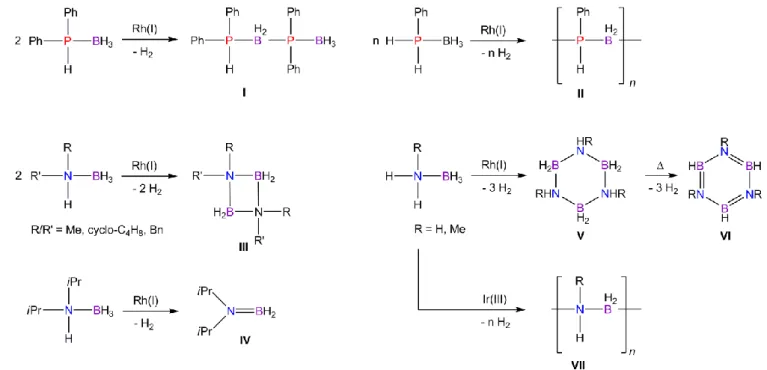
![Figure 3. ESI-MS of polyphosphinoborane (3a) from reaction with 5 mol% [(η 5 :η 1 -C 5 H 4 C 10 H 14 ) 2 Ti] (1) at 0 °C, showing three different possible end groups](https://thumb-eu.123doks.com/thumbv2/1library_info/3735725.1509016/37.892.226.718.670.1084/figure-esi-polyphosphinoborane-reaction-showing-different-possible-groups.webp)
